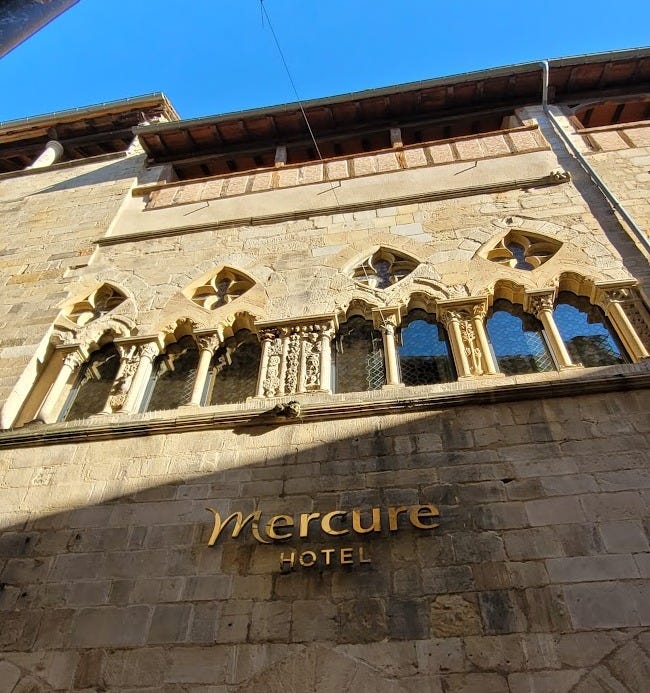A bit before Valentine’s Day, I wrote about how I had escaped to Figeac (Lot, Occitanie) and fallen head over heels in love.
But I got distracted by la Côte d’Azur, and never followed up on my Figeac fling.
This was wrong of me. The sous-préfecture of the Lot department, home to nearly 10,000 Figeacois and Figeacoises, deserves great attention — especially for its architectural majesty.
The “Stunning Architecture per Square Meter” Label
The French have a label for everything, so what’s one more ? I would gladly award it to Figeac for the density of its impressive historical buildings.
Step into the town center, and you’ll quickly find yourself stopping, staring and snapping just about everywhere. In fact, “stopping, staring, and snapping” has become my modus operandi when on a city jaunt.
Figeac inspired me to dig deeper.
Rather than a facile photo-bomb, which I certainly have the stuff to do, today you’re getting a focus on just three emblematic Figeacois buildings.
La Maison du Viguier du Roy
Un viguier was a local deputy of the King (roy at that time), an especially top dog in southern France. In Figeac, a succession of viguiers lived in this splendid complex for over four centuries.
After the French revolution, the home reverted to private property, but eventually fell into ruins. Plans were even afoot to turn the area into a — gasp — parking lot!
Apparently hungry for a little project, Philippe and Anne Secordel-Martin purchased it in 1986, undertaking an enormous renovation involving 40 companies before opening it up as a luxury hotel in 1990.
The Secordel-Martin closed their business in 2008, and, despite my best research efforts, what happened to it over the next decade is a bit fuzzy. But the town bought it in 2018, and got a project going with:
If you don’t know of les hôtels Mercure, just think the huge international Groupe Accor. It seems like an odd match, but it’s working out.
Pro tip from l’Office de Tourisme: if you want to visit this historical site, you have to march right into the hotel lobby, introduce yourself as a visitor, and then you will be (rather alarmingly) free to wander around. You may feel odd doing this, but I guarantee it’s worth it.
La Maison du Griffon
Un griffon is a griffin, but I’m not sure I see one on this façade, so do tell me if you do.
That necessary point aside, this building is reputed to be Figeac’s oldest, its structure dating back to 1175.
The ground floor originally reached above the first pair of shutters, making it lofty for the Middle Ages. But during the 19th century, a mezzanine was added above the shop level. And somewhere along the line, the building got decapitated, losing its top storey.
Arcades were open spaces for centuries, and in Figeac merchants were not allowed to fill them in with closed shops until the late 1800s.
And those wood shutters that we all ooh and ah about? They came into use late in the 18th century, becoming especially popular in the 19th.
All right, I knew deep down inside that painted wood shutters were not a medieval architectural feature. But I find that when visiting a town with such Certifiably Old Architecture, I tend not to give much thought to exterior changes wrought over the centuries — and to be honest, I don’t know much about them. What about you?
La Maison Duchêne
The Duchêne were just a family, so enough said there.
This house also bears witness to how a building can be greatly transformed over hundreds of years, yet look like one unified piece today — well, except for the shuttered bank.
The arcades go back to the 14th century, but all of the upper floors were rebuilt during the 17th, with the small tower, or tourette, mainly a sign of wealth. The top floor solelho, or attic area, would have likely been added at the same time.
Solelhos are a major feature of Figeacois architecture; you can see one in each of the photos above, and all over the city center. Originally open areas, most have been closed over the years in order to be used as living space.
My conclusion? Within old buildings lie many incarnations, and I would do well to pay this a bit more mind.
Special mention of a great source I used for this publication:
The excellent and detailed book Le Guide Figeac by Les Editions du Patrimoine , published by the French Ministry of Culture — which no one is taking a chain saw to.
France in Between will be 100% free for the foreseeable future, but your support is greatly appreciated in the form of a contribution, large or small!








Thanks for this, Betty. We are going back to Figeac in the Fall. I remember it as stunning!
I hope you visited the museum of writing while you were there. It’s fantastic — one of the best museums I’ve ever visited.